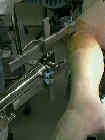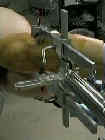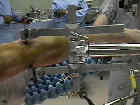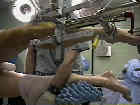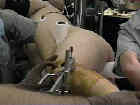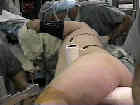- Assess ISS:
- w/ multiple injuries (Pelvic Frx) consider supine position and use of universal femoral distractor;
- 45 deg Lateral on Flouro Table:
- indications:
- include ipsilateral femoral and acetabular frx or vertical unstable pelvic fracture;
- bilateral lower extremity injury;
- floating knee injury;
- unstable spine frx;
- requires use of universal femoral distractor;
- ref:
- Intramedullary Nailing of Acute Femoral Shaft Fractures Without a Fracture Table: Technique of Using a Femoral Distractor.
- Frx Table: Supine Position:
- Indications: multiple injuries (pulmonary, spine, pelvis);
- advantages:
- closed reduction is easily achieved w/ supine positon, & problems of rotatory position are corrected;
- disadvantages:
- difficulty w/ trochanteric entry hole;
- proximal 1/3 fr tend to angulate in varus w/ supine position, which may require switching to lateral position;
- w/ proximal frx, ensure that ipsilateral hip is moved to edge of table, and that the torso & leg are adducted away from ipsilateral hip;
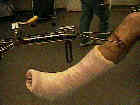
- technique:
- adduct torso and thigh away from trochanter;
- trunk and pelvis of patient are tilted away from the injured leg, providing a degree of adduction of the hip;
- place bump under hip, and airplane table;
- w/ concomitant foot and ankle injuries, surgical delays and/or significant fracture shortening, consider use of skeletal traction
- Frx Table: Lateral Position:
- advantages:
- ideal for the obese patient;
- easier for the trochanteric entry hole;
- proximal 1/3 frx tend to angulate in varus w/ supine position, and adjustments in pt positioning including switching to the lateral position may be necessary;
- disadvantages:
- in lateral position, proximal fragment tends to flex and adduct;
- technique:
- when lateral position is chosen, both vertical & longitudinal posts on fracture table to hold the pelvis;
- hip is slightly adducted & moderately flexed to improve reduction of the fracture and enhance access to the trochanter;
- traction should be applied thru distal femoral traction pin w/ knee flexed 60 deg;
- Complications:
- pundendal nerve palsy:
- may occur in upto 15% of patients who are placed supine on the frx table;
- does not seem to be a complication of lateral positioning, which may be due to the fact that a large, more padded post is used in the lateral position;
- may be avoided by minimzing by adequate padding the peroneal post and by minimzing the amount of traction applied;
- further peroneal palsy may be decrease by avoiding prolonged adduction of the leg;
- compartment syndrome:
- may occur as complication of prolonged positioning in hemilithotomy position;
- ref: Compartment syndrome of the well leg as a result of the hemilithotomy position: a report of two cases and review of literature.
Abduction strength following intramedullary nailing of the femur.
Pudendal nerve palsy complicating intramedullary nailing of the femur.
Pudendal nerve palsy after femoral intramedullary nailing.
Intramedullary Nailing of Femoral Fractures in Morbidly Obese Patients.
A vascular complication of trochanteric-entry femoral nailing on a fracture table


